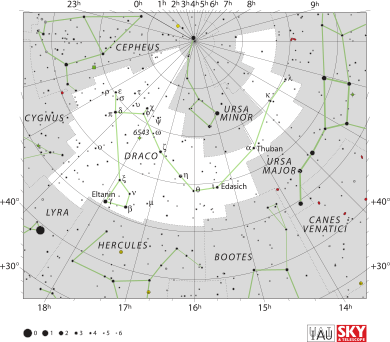Draco (constellation) facts for kids
| Constellation | |

List of stars in Draco
|
|
| Abbreviation | Dra |
|---|---|
| Genitive | Draconis |
| Pronunciation |
|
| Symbolism | the Dragon |
| Right ascension | 17h |
| Declination | +65° |
| Quadrant | NQ3 |
| Area | 1083 sq. deg. (8th) |
| Main stars | 17 |
| Bayer/Flamsteed stars |
76 |
| Stars brighter than 3.00m | 3 |
| Stars within 10.00 pc (32.62 ly) | 7 |
| Brightest star | γ Dra (Eltanin) (2.24m) |
| Messier objects | 1 |
| Meteor showers | Draconids |
| Bordering constellations |
|
| Visible at latitudes between +90° and −7°. Best visible at 21:00 (9 p.m.) during the month of July. |
|
Draco is a large constellation in the northern sky. Its name comes from the Latin word for "dragon." It looks like a long snake or dragon winding between the Big Dipper and the Little Dipper.
Draco is one of the 48 constellations listed by the Greek astronomer Ptolemy in the 2nd century. It is still one of the 88 modern constellations we use today. Because it is close to the North Pole, Draco is a circumpolar constellation for people in the Northern Hemisphere. This means it never sets below the horizon and can be seen all year round.
Contents
Stars and Features
The North Star
One of the most famous stars in Draco is Thuban (Alpha Draconis). Today, our North Star is Polaris, but this was not always the case. Around 3942 BC, Thuban was the star closest to the North Pole.
The ancient Egyptian Pyramids were built to align with Thuban. The entrance passages were designed so that this star would be visible at night. Because the Earth wobbles slowly over time (a process called precession), the North Star changes over thousands of years. Thuban will become the North Star again around the year 21000.
Bright Stars
Draco has several bright stars that make up the dragon's body and head.
- Gamma Draconis (Eltanin): This is the brightest star in Draco. It is an orange giant star located 148 light-years away from Earth. Its name means "the great serpent."
- Beta Draconis (Rastaban): This yellow giant star is near Eltanin. Its name means "head of the serpent."
- Nu Draconis: This is a binary star, which means it is actually two stars orbiting each other. They look like a pair of eyes in binoculars.
Deep Space Objects
Draco contains many interesting objects beyond our own galaxy.
The Cat's Eye Nebula
The Cat's Eye Nebula (NGC 6543) is a planetary nebula about 3,000 light-years away. It formed when a dying star threw off its outer layers of gas. In pictures taken by the Hubble Space Telescope, it looks like a complex, colorful eye. It was one of the first nebulas of its kind to be discovered.
Galaxies
There are several galaxies in Draco:
- Draco Dwarf Galaxy: This is a small, faint galaxy. It is one of the least bright galaxies known to astronomers.
- NGC 5866 (Spindle Galaxy): This is a lenticular galaxy, which is shaped like a lens.
- Arp 188 (Tadpole Galaxy): This galaxy has a long "tail" of stars that is 280,000 light-years long. The tail was formed when another galaxy passed close by and pulled stars away with its gravity.
Myths and Legends
Greek Mythology
In Greek mythology, Draco is often identified as Ladon. Ladon was a dragon with one hundred heads who guarded the golden apples in the garden of the Hesperides.
One of the famous labors of Hercules was to steal these golden apples. To do this, Heracles (Hercules) had to defeat the dragon. After the battle, the goddess Hera placed the dragon in the sky as a constellation to honor its service. In the sky, the constellation Hercules is seen standing with one foot on Draco's head.
Another story says Draco was a dragon that fought the goddess Athena during a war between the gods and the giants. Athena threw the dragon into the sky. It became twisted and froze in the cold northern sky before it could untangle itself.
Arabic Astronomy
In traditional Arabic astronomy, the stars of Draco were not seen as a dragon. Instead, they were called the Mother Camels. The stars represented a group of camels protecting a baby camel from two hyenas.
Meteor Showers
The Draconids are a meteor shower that happens every year in October. The meteors appear to come from the direction of Draco.
Usually, this shower is quiet, but sometimes it produces a "storm" of meteors. In 1933 and 1946, observers saw thousands of meteors per hour. In 2011, there was another burst of activity. The meteors come from dust left behind by a comet named 21P/Giacobini-Zinner.
Draco in Culture
The constellation has inspired names in books, movies, and games.
- Draco Malfoy: A major character in the Harry Potter series is named after this constellation.
- Dragonheart: In this 1996 movie, the constellation Draco is a heaven for dragons who kept their promise to protect humanity.
- Chess: The "Dragon Variation" is a popular opening strategy in the game of chess. It is part of the Sicilian Defense.
See also
 In Spanish: Draco (constelación) para niños
In Spanish: Draco (constelación) para niños
- Draco (Chinese astronomy)
- List of the star names in Draco
- Ursa Major
- Ursa Minor




